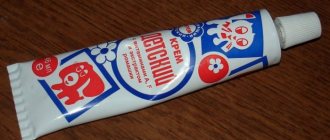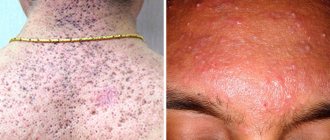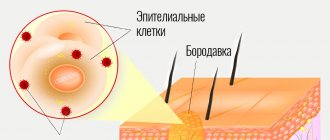Cosmetologists distinguish 4 main types depending on the intensity of the sebaceous glands:
- Fatty;
- Normal;
- Dry;
- Combined.
Also, the skin can be problematic, sensitive, aging, but these are additional characteristics that are usually combined with the main ones. For example, problematic skin is usually oily, while sensitive skin is usually dry.
- Normal skin has a pH of 5.5 and a healthy, even tone. It is elastic, with small pores, well moisturized. In essence, this is an ideal option, which, like any ideal, is quite rare;
- Oily skin is dense, thick, with enlarged pores and an oily sheen. The pH value is 6. Rashes and acne are often observed - the secretion that accumulates in the pores is an ideal breeding ground for bacteria. The advantage of the oily type is that such skin remains smooth and wrinkle-free for a long time;
- If the skin is dry, then the activity of the sebaceous glands is reduced, the pores are almost invisible, the complexion is often dull, and there is no shine. pH value - from 3 to 5.5. In youth, the epidermis looks attractive, but over the years it loses moisture and becomes covered with wrinkles and begins to peel off. But acne usually does not occur;
- Combination or mixed skin is the most common option. In the T-zone (i.e. in the forehead, nose and chin) the skin is oily, while around the eyes, on the cheeks and temples it is dry. The degree of oiliness and dryness may vary. This type is easy to distinguish by its heterogeneous structure and uneven shade.
As you age, your skin type may change. If in youth most people have oily skin, then with age it becomes increasingly dry. For this reason, it is impossible to choose the right care once and for all - it is necessary to regularly change cosmetics depending on the current needs of the skin.
Care for combination skin in summer and winter
Yes, combination skin care may vary depending on the time of year. Let's find out what points you should pay special attention to.
Summer care
In summer, the skin usually reduces the rate of sebum production, but is prone to excessive sweating and moisture loss. Summer care for combination skin should include intensive hydration and long-term maintenance of moisture levels in the upper layers of the skin. In this case, you can use products that are lighter in texture and labeled “non-comedogenic.”
In summer, it is important to supplement combination skin care with protection from ultraviolet rays. Products that combine moisturizing and SPF can help with this.
Winter care
In winter, combination skin is exposed to various aggressive environmental factors. These include temperature changes, sharp or cold winds, dry air due to the heating season... Caring for combination skin in winter should be aimed at strengthening the hydrolipid mantle of the skin, supporting its protective functions, and reducing discomfort due to negative factors.
How to determine your type yourself?
The easiest way is to evaluate the appearance of the face.
All you need for this is a mirror and good lighting. If a recently washed face shines over the entire surface, and the pores are enlarged, then the epidermis is probably oily. If shine is observed only in the central part, then we can talk about a combined type. Matte, delicate skin, prone to flaking - most likely dry. Normal skin is smooth, elastic and lacks pronounced shine.
The second method is using a cosmetic wipe.
Three to four hours before the test you need to wash your face, without using any creams, serums or even toner after that. After the specified period, you need to apply a napkin to your face and see if there are any greasy stains on it. If they are present over the entire surface, then the skin is oily. The presence of abundant discharge in the T-zone and its absence in the cheek area is a sign of a mixed type. Small oily spots indicate normal skin. If there is no discharge at all, this indicates dryness of the epidermis.
There are various questionnaires that allow you to assess the level of activity of the sebaceous glands. Questions may be devoted to the reaction of the epidermis to various cosmetics and washing. For example, if after washing there is a feeling of tightness, this indicates dryness, and the release of fat in response to the use of a nourishing cream indicates increased activity of the sebaceous glands.
Care at different ages
With age, the body's needs change. What suited you at 20 will no longer do the job at 40. That’s why it’s so important to change your skincare products on time.
Until the age of 25, the only problem may be acne. Use clay masks and don’t forget about quality cleansing. Well, hydration should be on your daily list of must-dos.
After 25 years, you need to start using cosmetics that prevent the occurrence of wrinkles.
After 35 years, the first signs of aging appear. To minimize them, use a more nourishing moisturizer or oil.
After 40 years, you need to start doing facial massage. For example, special glass jars. They will allow you to prolong your youth as much as possible.
Skin type and aging
With age, the epidermis and deep layers of the dermis lose moisture. This process occurs most quickly in those with dry skin that is not protected by sebaceous gland secretions. In this case, the face quickly becomes covered with a network of wrinkles. Happy owners of a normal type age more slowly, and those who in their youth suffered from excessive oiliness of the epidermis continue to enjoy the smoothness of their faces for a long time. However, time does not spare them either: dense and thick skin is not prone to the formation of fine wrinkles, but deep folds often appear on it.
The process of withering is accompanied by a loss of elasticity and the appearance of sagging. Large and small wrinkles, pigmentation, and vascular defects appear. Facial features lose clarity, volume moves from the cheekbones downwards - jowls and a double chin appear.
All these changes can be corrected in the early stages. The main thing is not to miss the moment and visit a cosmetologist in time, who will develop an effective anti-age strategy taking into account your skin type and age-related changes.
Suitable Ingredients for Combination Skin
You read the ingredients of the products you apply to yourself, right? For the combined type, the following ingredients are most relevant:
- Glycerin and hyaluronic acid create a protective barrier that does not release the necessary moisture outside.
- Antioxidants (for example, vitamins C and E) - prolong the youth of the skin.
- Lipid-reducing components - protect against dehydration.
- Clay and zinc have bactericidal properties and reduce sebum production.
- Salicylic acid and retinoids - ensure renewal of the dermis, eliminate wrinkles and acne.
- Panthenol - soothes irritated skin.
What to do after determination?
The next step is to select care taking into account your skin type and other features. It is best if a care strategy is developed by a specialist who takes into account not only the degree of oiliness of the epidermis, but also other nuances. But the general direction of care can be determined independently.
It should be taken into account that:
- The more active the sebaceous glands are, the lighter textures should be used;
- Everyone needs hydration, but it is especially important to hydrate dry skin;
- Products for the care of oily skin contain anti-inflammatory additives, since increased oiliness of the skin is often accompanied by rashes;
- Absolutely everyone needs UV protection;
- Creams “for all skin types” are best suited for the care of normal skin; in other cases, it is better to give preference to products that meet the needs of your skin.
If you don’t have time to select cosmetics at random, or if you are unhappy with the condition of your skin, it is better to make an appointment with a cosmetologist and receive individual recommendations on self-care. This approach allows you to achieve the optimal effect, saving time and money.
Dry skin
Dry skin comes in many forms and can – if it is very dry – resemble sensitive skin. This is due to a weakened protective barrier. Dry skin often lacks moisture, both in the form of water and oil, and can also become very red.
Features of dry skin: has visible dryness and small pores, is prone to wrinkles and has poor elasticity. The skin in some areas is dense and rough. You feel tightness and itching, especially after washing your face, and your skin is dry. It is also characterized by surface peeling and periodic redness.
Dry skin
Pronounced superficial and deep wrinkles on dry skin
It is important to distinguish between dry and dehydrated skin:
- Dry skin is caused by a lack of oil secretion;
- Dehydration is a temporary skin condition that can be corrected with moisturizing treatments. Skin dehydration is caused by climatic and environmental conditions.
If your skin describes more than one of the following, you probably have dry skin:
- It has a matte surface and feels dry to the touch, and in some cases almost rough;
- Contracts when wrinkling the nose or forehead;
- The pores are almost invisible;
- Quickly absorbs the cream;
- Problems with facial makeup, often applied unevenly;
- There is no great tendency for pimples to appear, but they can occur in places;
- Skin care products may sting when applied;
- Fine lines and wrinkles on the skin are noticeably reduced after using moisturizer.
Contaminated skin
The condition is characterized by open and closed comedones (blackheads) and blockages beneath the surface of the skin. The skin has an uneven surface.
Contaminated skin with closed comedones
The black color of acne is oxidized sebum, not dirt. The second type of blockage, a pimple, is located on the outside of the pore and is often yellow in color. You probably tried to squeeze them out, and saw that the contents were a yellowish liquid. The final type of blockage is a pimple that sits under the skin, and it tends to be very painful and uncomfortable and also takes longer to heal.
If one or more of the following descriptions apply to you, this is a sign that your skin is clogged:
- Small blackheads around the skin, mainly located around the nose and cheeks;
- Swollen pimples with a yellow “head” around the face. They vary in size and usually occur on the forehead, around the mouth and near the nose;
- You experience uncomfortable, swollen, and painful pimples that sit under the skin and can be painful.
How to choose a cream for oily skin?
There are several typical signs of oily skin. The most common of them are enlarged pores, greasy shine, to which blackheads are sometimes added. Creams for oily skin are designed to solve specific problems:
- Nutrition. In the autumn-spring period, the condition of the epidermis may worsen due to a deficiency of vitamins and minerals in the body. During this period, it is advisable to use special products that can saturate the cells with the necessary active substances.
- Hydration. Dehydration of cells leads to worsening flaking of the skin. It is important to restore the hydrobalance in a timely manner, otherwise the sebaceous glands will begin to secrete more sebum, which in turn provokes the formation of new acne*. The composition of a face cream for oily skin should include components such as salicylic, glycolic, hyaluronic acid, vitamins A, B, C, E, as well as essential oils and extracts of medicinal plants. Each of these components has unique properties that will help improve the condition of the epidermis.
- Matting. Oily shine, blackheads, enlarged pores look unaesthetic. Using mattifying cosmetics, you can disguise existing imperfections. It usually contains vitamins C and E, panthenol, hyaluronic and salicylic acid, as well as sorbents in the form of powder, talc, clay, zinc or starch. Mattifying cream can perform several tasks at once: narrow pores, maintain cell hydrobalance, control sebum secretion, and have antibacterial and antiseptic effects.
To slightly hide existing aesthetic defects, use foundation for oily skin. When choosing, keep in mind that oily skin does not tolerate heavy and oily textures. Therefore, it is better to choose light creams or fluids that have high covering power. It would be good if the foundation contains the following components:
- Antioxidants. Resveratrol, vitamins C and E, polyphenols protect cells from free radicals, prevent early aging, slowing down oxidation processes.
- Hygroscopic agents. Glycerin, panthenol, hyaluronic acid absorb moisture and create a barrier that maintains water balance in cells.
- Sorbents. Powder, clays, zinc, starch, talc absorb sebum and give the face a matte finish.
- Salicylic acid. Promotes exfoliation of dead epidermal cells, activates regeneration processes, evens out the color and texture of the face, and effectively fights local inflammation.
- Additional components. Emulsifiers combine all the ingredients into a single formula, and stabilizers help preserve it.
For oily and problem skin, two effects that foundations provide are of particular importance - durability and mattification. To maintain tone and maintain a youthful face, you need to regularly use day cream for oily and combination skin. At the same time, it is important that it does not create a greasy and dense film on the face.
Sensitive skin
Sensitive skin is best described as “reactive” skin. This means that it reacts and changes character depending on its environment. Depending on how sensitive your skin is, it can react to everything from changes in temperature or humidity, the cosmetics you use, touch, and more. Many people confuse dry or irritated skin with sensitive skin, but in reality, sensitive skin may be oilier and suffer from impurities and breakouts.
Features of sensitive skin: it is thinner, lighter and more sensitive, with impaired barrier function and a large number of capillaries. The skin has an uneven structure. Requires special care and caution when using new cosmetics. People with sensitive skin who are more exposed to the sun develop eczema or rosacea.
Rosacea on sensitive facial skin
If your skin describes more than one of the following, you probably have sensitive skin:
- Varies greatly from season to season;
- Makeup and grooming are often associated with acne;
- Tends to become hot and red when touched or physically affected (such as from cleansing masks or facial scrubs);
- Lots of redness on the skin in general;
- Allergy, rash, itching, dryness;
- Flushes easily from heat or cold;
- Not all means are suitable. Often experiences adverse reactions when using new products;
- Unpredictable and can change greatly from day to day.
How to properly care for facial skin after 30 years
Expression wrinkles noticeably appear in the corners of the eyes, forehead, and lips from the age of 30. The skin is no longer so elastic and smooth. Therefore, at this age you need to know how to properly care for your facial skin. When using creams and serums, pay attention to the composition, because the skin at this age requires special components, in particular an SPF filter to maintain good condition, protection from sunlight and radiation from a working monitor.
If puffiness occurs under the eyes in the morning, do not consume liquid in the evening. Two hours before bedtime - the last fluid intake. Twice a week it is necessary to carry out procedures using moisturizing and nourishing masks.
Read material on the topic: How to care for facial skin: home care and salon treatments










